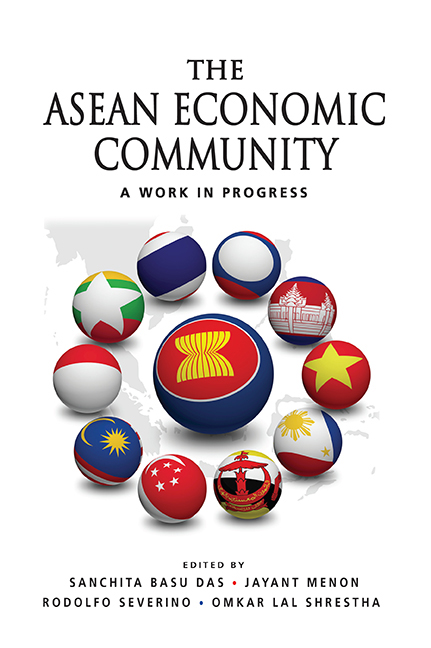Book contents
- Frontmatter
- Contents
- Foreword
- Foreword
- Preface
- acknowledgments
- Abbreviations
- The Contributors
- 1 Overview
- 2 Non-Tariff Barriers: A Challenge to Achieving the ASEAN Economic Community
- 3 ASEAN Trade in Services
- 4 The Asean Economic Community: The Investment Climate
- 5 Competition and Intellectual Property Laws in the ASEAN ‘Single Market’
- 6 Subregional Zones and ASEAN Economic Community
- 7 ASEAN FTAs: State of Play and Outlook for Asean's Regional and Global Integration
- 8 The Asean Dispute Settlement System
- 9 Enhancing the Institutional Framework for AEC Implementation: Designing Institutions that are Effective and Politically Feasible
- 10 ASEAN Economic Community Business Survey
- Index
2 - Non-Tariff Barriers: A Challenge to Achieving the ASEAN Economic Community
Published online by Cambridge University Press: 21 October 2015
- Frontmatter
- Contents
- Foreword
- Foreword
- Preface
- acknowledgments
- Abbreviations
- The Contributors
- 1 Overview
- 2 Non-Tariff Barriers: A Challenge to Achieving the ASEAN Economic Community
- 3 ASEAN Trade in Services
- 4 The Asean Economic Community: The Investment Climate
- 5 Competition and Intellectual Property Laws in the ASEAN ‘Single Market’
- 6 Subregional Zones and ASEAN Economic Community
- 7 ASEAN FTAs: State of Play and Outlook for Asean's Regional and Global Integration
- 8 The Asean Dispute Settlement System
- 9 Enhancing the Institutional Framework for AEC Implementation: Designing Institutions that are Effective and Politically Feasible
- 10 ASEAN Economic Community Business Survey
- Index
Summary
Introduction
A significant milestone of economic integration in the ASEAN region is the substantial progress in tariff liberalization, with the average tariff rate now at less than 5%. The achievement in tariff reduction, however, has been marred by non-tariff barriers (NTBs). While the commitment to eliminate NTBs has always been an integral part of the liberalization program of the ASEAN member states, little progress has been made to address them.
There are increasing concerns about NTBs. First, they have replaced tariffs as protective measures for domestic industries (World Bank 2008). Second, the bulk of intra-regional trade transactions among the ASEAN economies is driven by the global production networks of multinational companies in the region. Efficiency in moving goods across borders has thus become crucial in capturing and creating trade opportunities arising from the vertical and horizontal operations of these networks (Austria 2004). Third, behind-the-border interventions have increasingly emerged as the new form of protectionism since the recent global economic crisis (Wermelinger 2011). This is also observed with the shifting of growth potentials away from developed countries and toward developing countries.
NTBs could undermine the economic integration process and the realization of the AEC by 2015. Unlike tariffs, whose effect on trade is certain (i.e., direct effect will increase the price of imports), the effects of NTBs are ambiguous. They can be restrictive of trade, some may even promote it. Also, when they come in the form of regulatory measures, they may affect different products and different countries in different ways.
Given that the 2015 target for AEC is fast approaching, it is essential to examine closely the non-tariff issues affecting the economic integration of the region. The objectives of this chapter are as follows: (i) to identify and examine the non-tariff barriers affecting the integration of the priority sectors in the ASEAN region; (ii) to assess progress in the implementation of actions in the AEC Blueprint that are meant to address NTBs; (iii) to examine the possibility (or impossibility) of achieving the AEC by 2015; and (iv) to identify policy issues as well as make recommendations to address NTBs in the region.
- Type
- Chapter
- Information
- The ASEAN Economic CommunityA Work in Progress, pp. 31 - 94Publisher: ISEAS–Yusof Ishak InstitutePrint publication year: 2013



